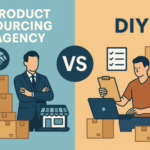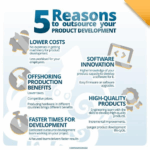Not every project needs to be handled in-house. Sometimes, bringing in outside experts is the smartest way to move an idea forward. Whether you’re short on time, skills, or resources, outsourcing parts of product development can help you move faster, reduce costs, and stay focused on your core business.
Managing all of this in-house can be costly and time-consuming. That’s where outsourcing comes in. When done right, outsourcing product development services can help businesses move faster, stay focused, and tap into specialized expertise they may not have internally.
What Does It Actually Mean to Outsource Product Development?
Working with an external team allows businesses to manage parts or all of the product development process without building an in-house team. This can include tasks like design, prototyping, engineering, or even final production.
Not every company handles product development the same way. Some hand over the entire process from start to finish, while others just bring in outside help for certain parts—like creating 3D models or writing firmware. It really depends on what skills they have in-house and where they need extra support.
When Outsourcing Makes Sense?
Getting support from external experts can be a smart choice, especially when your team is overloaded with work or doesn’t have the right skills for the task. It helps you move projects forward more efficiently without putting extra pressure on your internal resources.
It’s also a good fit when entering a new market or industry where you’re not confident in local regulations or technical standards. Outsourced partners often bring regional knowledge and established processes that reduce risk.
And if speed is a top priority such as being first to market or catching a trend an experienced external team can move much faster than hiring and training one internally.
Benefits of Outsourcing Product Development
Outsourcing isn’t just about delegating work, it’s about gaining efficiency, expertise, and flexibility. Here are some key advantages businesses often experience:
- Access to Experts: You tap into specialized talent designers, engineers, developers without hiring full-time staff.
- Faster Time to Market: External teams often have efficient processes that help bring products to market sooner.
- Cost Control: You avoid the overhead of building an in-house team while gaining access to high-quality development resources.
In short, outsourcing allows businesses to stay efficient while still innovating. It’s about doing more with less without sacrificing quality or speed.
Common Tasks That Can Be Outsourced
Product development includes a wide range of tasks, many of which are ideal for outsourcing. This approach allows you to stay focused on strategy while accelerating development behind the scenes.
These can include:
- Concept design and feasibility studies
- CAD modeling and prototyping
- Material selection and supplier coordination
- Software development for digital products
- Testing, compliance, and quality assurance
Working with external partners doesn’t have to mean giving up control. You can keep ownership of your core vision while letting experts handle the technical or time-intensive parts.
Things to Watch Out For
While outsourcing brings many benefits, it also comes with risks. Poor communication, cultural differences, and unclear expectations can lead to costly delays or missed deadlines.
One of the most common mistakes is rushing into a contract without proper evaluation. It’s important to review portfolios, ask for references, and establish clear timelines, roles, and deliverables from the start.
Intellectual property (IP) protection is another key concern. Make sure contracts include NDA clauses and clarify who owns what especially for proprietary technology or custom code.
In-House vs. Outsourced: How to Decide
In some cases, keeping product development in-house makes sense. If your team has the right skills, and you want tight control over every detail, building internally may be worth the investment. But for companies without deep technical resources or those looking to stay flexible, outsourcing services offers speed, scalability, and access to a wider talent pool.
It’s not always an either/or decision. Many businesses use a hybrid model, outsourcing some parts while keeping others internal based on their priorities and capabilities.
When to Bring Development Back In-House
As your company grows, you may decide to transition product development from an outsourced model to an internal team. This often happens when your product becomes more advanced, or when you’re ready to expand manufacturing.
Building in-house capability can also improve alignment between departments, speed up development cycles and deepen product knowledge within your company.
That said, outsourcing partners can still be valuable especially for specialized tasks or overflow work during busy periods.
Choosing the Right Product Development Services
Not all partners are the right fit. It’s important to choose a team with experience in your industry and a collaborative working style. Brand New MD offers outsourced product development services backed by clear processes, strong communication, and proven results.
Ask whether they handle work in-house, how they approach testing and feedback, and review their past projects. A reliable track record can make all the difference in reducing risk and for success.
Conclusion
For startups and growing businesses, working with an external team can be a major advantage — enabling faster development without compromising on quality. It offers access to specialized talent, efficient processes, and industry insight, all while keeping costs under control.
The key is choosing the right partner and setting clear expectations from the start. Whether you fully outsource or use a hybrid model, the aim remains the same: deliver better products, faster and with greater confidence.
Frequently Asked Questions
1. Is outsourcing product development more affordable than doing it in-house?
A: In most cases, yes. You avoid the cost of hiring, training, and managing a full team while still getting access to experienced professionals.
2. Will I lose control over the product if I outsource development?
A: Not if the partnership is managed well. You’ll still guide the vision and make key decisions — the external team simply executes more efficiently.
3. How do I protect my intellectual property when outsourcing?
A: Always have a signed NDA and a clear contract that outlines ownership of work, source code, and any custom technology.
4. Can I switch to an in-house team later?
A: Yes absolutely! Many businesses start by outsourcing and transition to in-house teams once they grow or want tighter control over the product.











